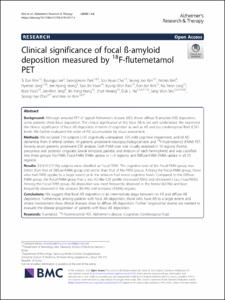Clinical significance of focal ß-amyloid deposition measured by 18F-flutemetamol PET
- Keimyung Author(s)
- Hwang, Ji Hye
- Department
- Dept. of Neurology (신경과학)
- Journal Title
- Alzheimer's Research & Therapy
- Issued Date
- 2020
- Volume
- 12
- Issue
- 1
- Abstract
- Background:
Although amyloid PET of typical Alzheimer’s disease (AD) shows diffuse ß-amyloid (Aß) deposition, some patients show focal deposition. The clinical significance of this focal Aß is not well understood. We examined the clinical significance of focal Aß deposition in terms of cognition as well as Aß and tau cerebrospinal fluid (CSF) levels. We further evaluated the order of Aß accumulation by visual assessment.
Methods:
We included 310 subjects (125 cognitively unimpaired, 125 mild cognitive impairment, and 60 AD dementia) from 9 referral centers. All patients underwent neuropsychological tests and 18F-flutemetamol (FMM) PET. Seventy-seven patients underwent CSF analysis. Each FMM scan was visually assessed in 10 regions (frontal, precuneus and posterior cingulate, lateral temporal, parietal, and striatum of each hemisphere) and was classified into three groups: No-FMM, Focal-FMM (FMM uptake in 1–9 regions), and Diffuse-FMM (FMM uptake in all 10 regions).
Results:
53/310 (17.1%) subjects were classified as Focal-FMM. The cognitive level of the Focal-FMM group was better than that of Diffuse-FMM group and worse than that of No-FMM group. Among the Focal-FMM group, those who had FMM uptake to a larger extent or in the striatum had worse cognitive levels. Compared to the Diffuse-FMM group, the Focal-FMM group had a less AD-like CSF profile (increased Aß42 and decreased t-tau, t-tau/Aß42). Among the Focal-FMM group, Aß deposition was most frequently observed in the frontal (62.3%) and least frequently observed in the striatum (43.4%) and temporal (39.6%) regions.
Conclusions:
We suggest that focal Aß deposition is an intermediate stage between no Aß and diffuse Aß deposition. Furthermore, among patients with focal Aß deposition, those who have Aß to a larger extent and striatal involvement show clinical features close to diffuse Aß deposition. Further longitudinal studies are needed to evaluate the disease progression of patients with focal Aß deposition.
- Keimyung Author(s)(Kor)
- 황지혜
- Publisher
- School of Medicine (의과대학)
- Citation
- Si Eun Kim et al. (2020). Clinical significance of focal ß-amyloid deposition measured by 18F-flutemetamol PET. Alzheimer’s Research & Therapy, 12(1), 6–6. doi: 10.1186/s13195-019-0577-x
- Type
- Article
- ISSN
- 1758-9193
- Source
- https://alzres.biomedcentral.com/articles/10.1186/s13195-019-0577-x
- Appears in Collections:
- 1. School of Medicine (의과대학) > Dept. of Neurology (신경과학)
- 파일 목록
-
-
Download
 oak-2020-0127.pdf
기타 데이터 / 1.11 MB / Adobe PDF
oak-2020-0127.pdf
기타 데이터 / 1.11 MB / Adobe PDF
-
Items in Repository are protected by copyright, with all rights reserved, unless otherwise indicated.